Le
Mans 24 Hours 2007
Friday - A "Day of Rest" June 15th 2007
In
the Garage
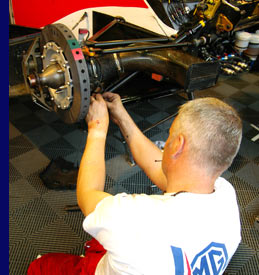 Long
perceived to be “a day of rest” in the build-up
to the Le Mans 24 Hours, Friday usually ends up being one
of the busiest of the week – certainly for the race
engineers and mechanics. The guys in the RML garage were
back at the circuit from the early morning, having worked
fairly late the night before, in order to begin the process
of stripping down, and then rebuilding, the MG EX264.
Long
perceived to be “a day of rest” in the build-up
to the Le Mans 24 Hours, Friday usually ends up being one
of the busiest of the week – certainly for the race
engineers and mechanics. The guys in the RML garage were
back at the circuit from the early morning, having worked
fairly late the night before, in order to begin the process
of stripping down, and then rebuilding, the MG EX264.
This
is a major exercise, since every sub-assembly is removed
– gearbox and rear suspension, engine, front suspension
and brakes included. Similar pre-prepared assemblies then
have to be bolted back onto the car, making sure that the
set-up that the team and drivers have worked so hard to
perfect, is replicated exactly with the new components.
It’s a painstaking process, and every stage has to
be carried out with meticulous care and cleanliness. It
takes all day, and from time to time throughout that period,
troops of guests are toured through the garage to be shown
the car and have its complexities explained. It is a day
that must try the patience of each and every one of them,
yet they bear it with jovial good spirits.
Marshal's
Award
The
first call of the day came at 10:00, when a Press Conference
was staged in the RML Paddock Hospitality unit to mark the
inaugural presentation after last year’s Le Mans of
the RML Marshal’s Trophy. This is to be awarded annually
to the marshal who, in the opinion of the French Association
des Commissaires de Route, has made the greatest demonstration
of commitment, skill and bravery in the cause of marshalling
a the Circuit de la Sarthe, home of the Le Mans 24 Hours.
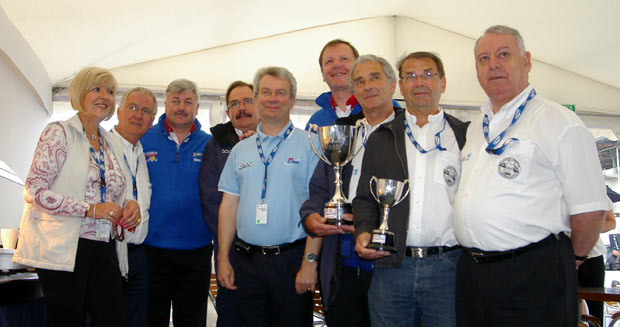
The
winning marshal in 2006 was Jacques Alanic, Commissaire
de Stands for the Le Mans 24 Hours 2006. His efforts, not
only during the 24 Hours, but also throughout the 2006 season,
were taken into account. Jacques was present at the Press
Conference, as were Daniel Poissenot, Race Director and
Deputy President of the Automobile Club de l’Ouest;
Fabrice Bourrigaud, ACO Marketing Director; Patrick Chaillou,
ACO Communications Director; and Daniel Perdrix, also of
the ACO.
Representing
the Association des Commissaires de Route, the French marshal’s
organisation, were Michel Chevereau, President; Raymond
Redon, Teasurer; Joél Esnault, Chief of the Arnage
Office, and André Froger. Jacques Alanic himself
was accompanied by several of his colleagues, including
Monsieur Gachet, Alain Tannier, Christian Dams and Christian
Petit, all Commissaires de Course at the Circuit de la Sarthe.
On
behalf of RML, Phil Barker was delighted to acknowledge
the invaluable role performed by the marshals at Le Mans.
Also attending were Ray Mallock, Chief Executive and Founder
of RML, and Adam Wiseberg, Motorsport Director of AD Holdings.
Ray
Mallock spoke afterwards. “The marshals are here to
help protect the lives of the drivers, and from my own personal
experience, they do a wonderful job. I recall being in a
race at Thruxton some years ago, and being involved in a
serious incident. The car broke in two, and I was knocked
unconscious. Moments later, the car caught fire. Initially
the marshals were driven back by the heat, but only for
a moment, and they quickly had the fire under control, and
then helped me from the car. That sort of experience makes
you realise how important their role is, and how right it
is that we should demonstrate our appreciation of everything
they do here with this Award. Their bravery and dedicated
is extraordinary, and we saw evidence of that on Wednesday
evening, when Marco Apicella had that horrendous accident
in the Lamborghini. It makes you grateful for everything
they do.”
Thomas
Erdos has never experienced an accident like Ray’s,
but he still values the marshals enormously. “You’re
always very aware of the fact that there are marshals all
around the track, and it makes you feel good to see them,”
he said. “It’s unbelievable that they devote
hours and days of their lives, often under difficult conditions,
to ensure that racing drivers are safer on the track, and
they do it for nothing. In many ways, they become marshals
for the same reasons we become drivers; for the love of
the sport, and it’s a great comfort to know that they
are there.”
Mike
Newton perhaps knows more about marshalling than almost
any other driver at Le Mans this year, since he started
his involvement in motorsport as a marshal in the Seventies.
“I started behind the barriers in 1977,” he
admitted. “That was some time before I became a racing
driver, but I still kept on marshalling, even after 1985
when I first raced, and I continued to do so until about
1990.” It proved to be a very fruitful period in his
life, and in 1991 he was present at the British “Marshal
of the Year” awards dinner. Uniquely, he ended up
marrying the recipient of that award; his wife Anne. “For
that reason, I really do appreciate everything that the
marshals do for us!” he grinned.
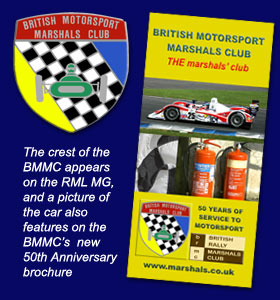 Mike’s
marshalling apprenticeship came at conventional race meetings
at circuits around the UK, and that can place different
demands upon the marshals behind the barriers. “In
a ten-lap sprint race, you have to get the cars cleared
away immediately after an accident, within a lap, and before
the rest all come round again. There’s no safety car,
so you can end up putting yourself in danger, and when you’ve
done that a few times, you really do begin to appreciate
the contribution that the marshals make to the overall safety
of motorsport.” In recognition of that fact, RML,
and Mike in particular, acknowledges the work that the marshals
do in two ways. “We keep in close touch with the British
marshals, and carry the badge of the British Motorsport
Marshals Club (BMMC) on the rear wing of the car. We also
sponsor the marshals in the UK with heavily subsidised race
suits. They have to be fireproof, of course, and with AD’s
help, it means they can afford the best quality overalls.”
Next time you’re at a British circuit, look out for
the orange suits with the AD branding on the back!
Mike’s
marshalling apprenticeship came at conventional race meetings
at circuits around the UK, and that can place different
demands upon the marshals behind the barriers. “In
a ten-lap sprint race, you have to get the cars cleared
away immediately after an accident, within a lap, and before
the rest all come round again. There’s no safety car,
so you can end up putting yourself in danger, and when you’ve
done that a few times, you really do begin to appreciate
the contribution that the marshals make to the overall safety
of motorsport.” In recognition of that fact, RML,
and Mike in particular, acknowledges the work that the marshals
do in two ways. “We keep in close touch with the British
marshals, and carry the badge of the British Motorsport
Marshals Club (BMMC) on the rear wing of the car. We also
sponsor the marshals in the UK with heavily subsidised race
suits. They have to be fireproof, of course, and with AD’s
help, it means they can afford the best quality overalls.”
Next time you’re at a British circuit, look out for
the orange suits with the AD branding on the back!
One
item of good news came through earlier in the day. After
due consideration of the weather conditions, the ACO decided
to waive their percentage lap-time requirement for all drivers
in the race. That means everyone will be able to compete
this weekend, although it’s doubtful that Mike’s
eligibility was ever in question.
In
addition, it has also been confirmed that the Lamborghini
team has been given special dispensation to enter a second
car. Normally a car cannot be re-shelled, unless the circumstances
are exceptional. On Wednesday the car was damaged beyond
repair, and while the team had a spare car in Paris, such
substitutions are not normally allowed. However, it is occasionally
possible to use a spare chassis, on the basis of safety,
provided the parts from the old car are fitted to the replacement
chassis. However, so severe was the impact that most parts
left over from the crash were also unsalvageable. Under
the exceptional circumstances created by Wednesday’s
crash, the ACO relented, and stating Force Majeure, have
allowed the team to collect their spare car, and it will
now start the race.
Pitlane
Walkabout
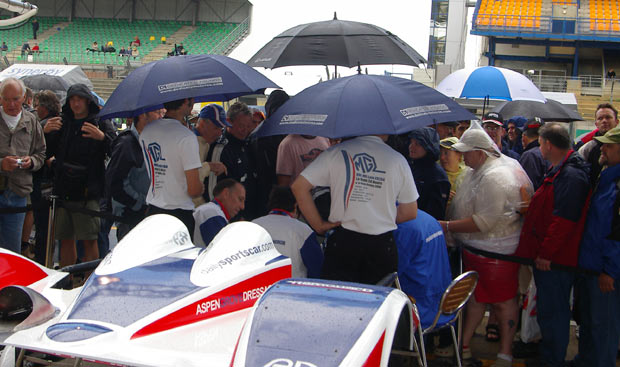
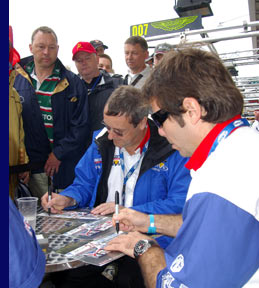 With
the marshal’s gathering over, Mike’s next task
on the Friday morning was to join Thomas Erdos and Andy
Wallace in front of the team garage. The three drivers,
sheltered from the persistent drizzle by a succession of
brolly-dollies, spent an hour signing autograph cards and
chatting with the thousands of spectators thronging the
pitlane. In the process, they signed almost 500 HeroCards
– and that in addition to a batch of several hundred
more that they had autographed the day before — those
in anticipation of the arrival of guests and visitors to
the team’s garage and hospitality.
With
the marshal’s gathering over, Mike’s next task
on the Friday morning was to join Thomas Erdos and Andy
Wallace in front of the team garage. The three drivers,
sheltered from the persistent drizzle by a succession of
brolly-dollies, spent an hour signing autograph cards and
chatting with the thousands of spectators thronging the
pitlane. In the process, they signed almost 500 HeroCards
– and that in addition to a batch of several hundred
more that they had autographed the day before — those
in anticipation of the arrival of guests and visitors to
the team’s garage and hospitality.
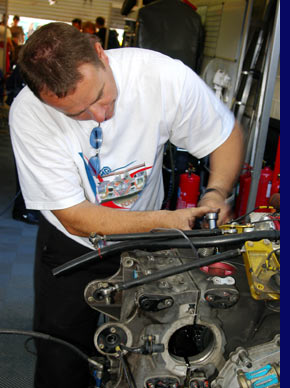 Throughout
all this time, work on preparing the MG continued, and by
lunchtime it was starting to look more like a racecar again.
As detailed by a special feature here,
one of those working hard was Mark Deacon (left).
A new arrival to the team, Mark’s day-job is as an
officer with London’s Metropolitan Police, but he
has been generously loaned to RML for the duration of the
Le Mans week. As an experienced restorer of classic cars
and an enthusiastic motorsport fan, Mark fitted in remarkably
quickly, and within a day or two was already being given
tasks that he could never have dreamed he’d be given
responsibility for only a week earlier.
Throughout
all this time, work on preparing the MG continued, and by
lunchtime it was starting to look more like a racecar again.
As detailed by a special feature here,
one of those working hard was Mark Deacon (left).
A new arrival to the team, Mark’s day-job is as an
officer with London’s Metropolitan Police, but he
has been generously loaned to RML for the duration of the
Le Mans week. As an experienced restorer of classic cars
and an enthusiastic motorsport fan, Mark fitted in remarkably
quickly, and within a day or two was already being given
tasks that he could never have dreamed he’d be given
responsibility for only a week earlier.
On
Friday he was delighted to be asked to work on the rear
sub-assembly. “They’re letting me strip down
the entire rear suspension and gearbox sub-assembly,”
he said. “I never for a second thought they’d
let me get my hands on the car, but here I am, working on
the rear suspension.” He admitted he felt like “a
kid let loose in a toyshop!”
Sportscar
Racing Forum & MGCC Visit
The
annual visit and pit tour for the guys from sportscar-racing.com,
our official web forum, took place at half-past two this
year. They were joined by members of the MG Car Club, starting
with an introduction to the drivers in the team hospitality.
Refreshments were followed by a question-and-answer session
hosted by Adam Wiseberg.
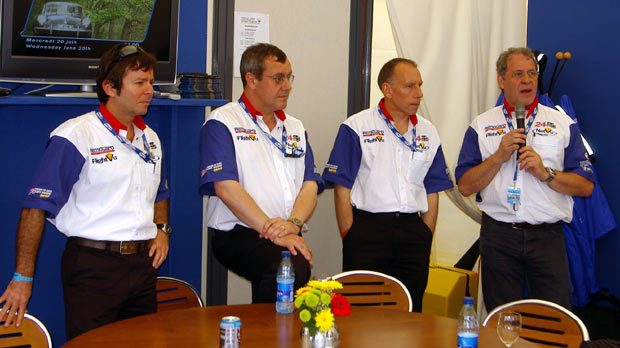
First
up was Tommy, who was asked about the process of setting
up a car for a race track like Le Mans, and covered topics
such as downforce, drag and suspension. Mike and Andy discussed
qualifying, with Andy going into some detail about the process
of setting a quick time when you’ve only got a single
flying lap to do it! His efforts on Wednesday were much
appreciated. He was then asked about his preference for
open or closed cockpits, and related the tale of his first
run at Le Mans in 1999 with the Audi R8 Coupé. Heading
down towards Indianapolis, one of the cockpit doors suddenly
opened, and was ripped away by the pressure of air. Glancing
upwards, he had just enough time to see it disappearing
off into the trees. He radioed in to the pits and told them
what had happened. “Which tree?” came the response.
“How do I know!!? replied Wallace, by this time negotiating
the corner and heading on towards Arnage. “Just get
another door ready and I’ll pit this time.”
There was a pause, then the call came back over the radio:
“We need to know which tree . . . . we don’t
have any more doors.” Needless to say, Andy prefers
an open-topped prototype.
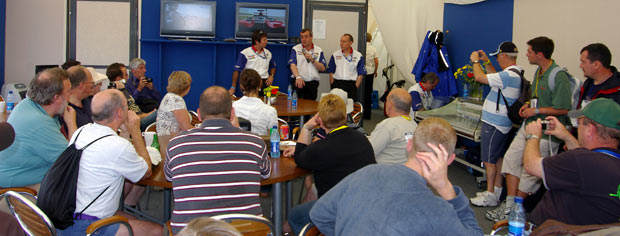
Tommy
then talked about the fact that he’d be taking the
race start. “They’ve changed the time this year.
Is it an hour earlier, or an hour later?” Well, “if
it’s five, we’ll all be in the pub having a
drink,” suggested Adam Wiseberg, knowing that the
correct time for the start is three this year.
Mike
was then asked about the new Lola “oh-seven”
nose and aerodynamic package, and why wasn’t the MG
using it here at Le Mans. “We need a low to medium
downforce setting for this track,” he explained, “and
we’ve proven that the older nose is more efficient
at lower-downforce settings.” There has also been
some debate about the strength of the newer nose, which
is a lighter lay-up and appears to flex more under load.
“When contact comes to you, there’s not a lot
you can do about it, so we’ll stick with the original
nose section, which seems more robust. The newer nose may
give two or three tenths over the course of the lap, but
we believe that strength is more important over twenty-four
hours. With two set-ups prepared on that nose, it should
be our strongest option for us this year.”
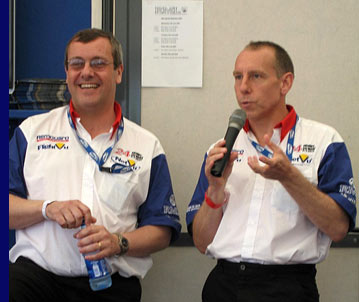 Andy
spoke briefly about the problem of punctures and deflating
tyres – an ever-present concern here at Le Mans. “Any
mechanical failure is pretty bad,” he said, “but
a tyre failing can be particularly serious. We have sophisticated
telemetry on the car, and a red light shows on the dash
whenever a tyre pressure falls. Most punctures are slow
– blowouts are fortunately quite rare – and
the sensors built into the wheel rims warn us of a slow
puncture. It’s the worst feeling possible when a tyre
goes bang, especially if it’s one at the back. That
brings at least one of the front wheels off the ground,
and with the front doing most of the work, that leaves you
with no steering and no brakes.” His advice then was
to steer into the barrier, preferable so that you hit the
tyres a glancing blow, so that you could slow down without
doing too much damage to the car. “Then it’s
usually a case of back to the pits for new tyres, and a
fresh pair of pants!”
Andy
spoke briefly about the problem of punctures and deflating
tyres – an ever-present concern here at Le Mans. “Any
mechanical failure is pretty bad,” he said, “but
a tyre failing can be particularly serious. We have sophisticated
telemetry on the car, and a red light shows on the dash
whenever a tyre pressure falls. Most punctures are slow
– blowouts are fortunately quite rare – and
the sensors built into the wheel rims warn us of a slow
puncture. It’s the worst feeling possible when a tyre
goes bang, especially if it’s one at the back. That
brings at least one of the front wheels off the ground,
and with the front doing most of the work, that leaves you
with no steering and no brakes.” His advice then was
to steer into the barrier, preferable so that you hit the
tyres a glancing blow, so that you could slow down without
doing too much damage to the car. “Then it’s
usually a case of back to the pits for new tyres, and a
fresh pair of pants!”
This
prompted Mike to relate one of his experiences as a marshal
at Oulton Park, when he was a driver on one of the fire
tenders. The brakes were so poor that the only way to stop
the things was to scrape down the barrier!
Tommy
then talked about the benefits of triple stinting, when
the tyres were durable enough to last three hours. “Once
you’re in the car, you get into a groove, and you’ve
got some kind of a rhythm going. If you can stop for fuel
but don’t have to change tyres, then you can keep
that rhythm going, and that can save maybe twenty seconds
or more on each stop.” The driver who stays in also
tends to be back up to speed more quickly that a fresh driver
would be, since he’s familiar with the conditions,
knows the limits of his tyres, and has the utmost confidence
in his car.
This
formal session was then followed by questions from the floor.
Last year the RML MG finished eighth overall. Could it do
better this year? Mike thought it was unlikely. “It’s
very different this year,” he said. “There is
far more factory involvement in LMP1, and the five diesels
will all probably still be going at the end.” Perhaps
a top-ten finish for the LMP2 winner might still be possible,
but not easy. How about the MG’s own chances? “Last
year we had the big unknown regarding the AER engine, which
had never done the full 24 hours before. Now we know it
can, and apart from Jarama, it’s been good every time.
We’ve updated the brakes too, so we like to think
we’ll do more laps than last year, and maybe we could
even improve on eighth, but it will be very hard.”
Adam
suggested that the three targets for 2007 were, firstly,
to finish, then to run trouble-free as much as possible,
and thirdly, to cross the line ahead of the leading GT1
cars. Andy was then quizzed about the car he drives here,
the MG Lola EX264, and the one he races for Dyson in the
States. What s the difference? “One’s British,
and one’s German!” came Adam Wiseberg’s
quipped reply! “We won’t really know until the
Porsche comes to race over here,” said Wallace. “The
Lola is a far more conventional car. It’s relatively
easy to set up, and it’s nice to drive,” he
added, before going on to explain that there may be twenty
times as many elements of the RS Spyder to adjust, and while
the Porsche might ultimately be the faster car, it was so
much more difficult to set up, especially for a circuit
like Le Mans, and under the kind of wet conditions we’ve
been experiencing this week. It was also worth remembering
that the Spyder racing in the ALMS is only as quick as some
of the LMP1 cars, like the Audi R10, because the American
rules allow for much bigger intake restrictors on the LMP2
engines, and in Europe, the Porsche would not have that
advantage. “With these long straights, we’re
probably better off with the MG Lola,” he concluded.
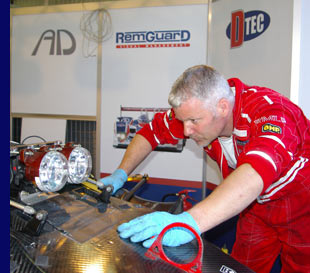 With
the time having passed three o’clock, the drivers
then headed off to prepare for their journey into the city
centre, where the evening’s Parade des Pilotes would
take place. The forum members, together with other MG enthusiasts,
were then invited to head round to the pitlane where Michael
Mallock would meet them for a guided tour of the RML garage.
With
the time having passed three o’clock, the drivers
then headed off to prepare for their journey into the city
centre, where the evening’s Parade des Pilotes would
take place. The forum members, together with other MG enthusiasts,
were then invited to head round to the pitlane where Michael
Mallock would meet them for a guided tour of the RML garage.
Michael,
accompanied by his fiancée Sam Clarke, then gave
a very individual , and insightful, explanation of the workings
and construction of the team’s Lola-based MG EX264.
Although he has never raced the MG, Michael’s experience
as a driver offered a different perspective on the more
technical aspects of the car, and appeared to be much appreciated
by the group. Thanks to him for offering his time, but also
to everyone who came along to express their support for
the team, and their interest in the car.
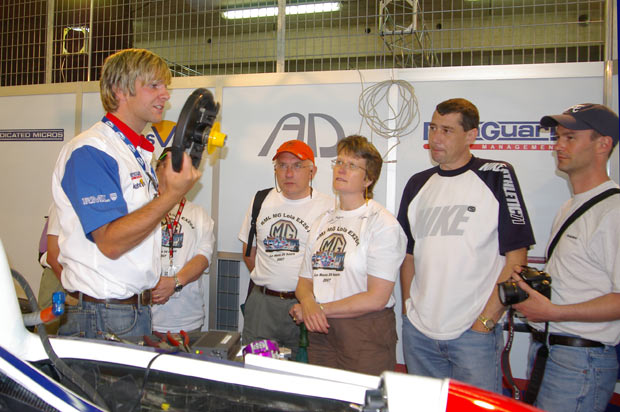
Michael's
tour was much appreciated, and if it offered a brief respite
from the rain, so much the better!
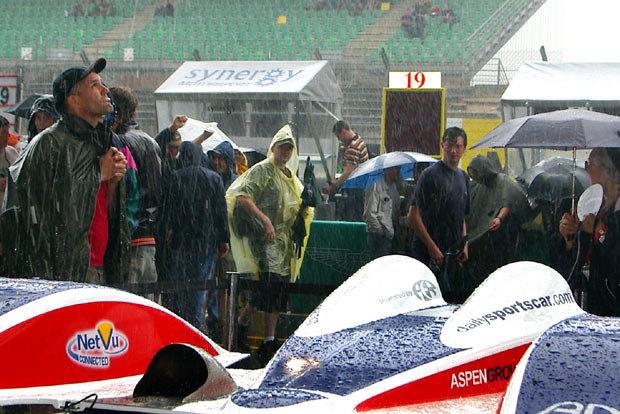
Driver
Parade
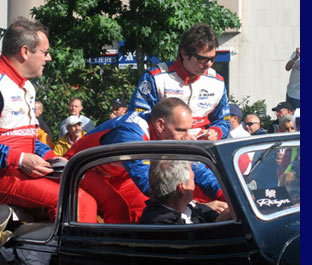 For
the next few hours work continued on preparing the MG for
tomorrow’s race. Down in the heart of Le Mans a vast
crowd had gathered to witness the traditional parade of
drivers through the streets, accompanied by marching bands,
supercars, jugglers, stilt-walkers and a succession of classic
cars, all staged within a colourful, noisy and very French
carnival atmosphere. Once again, as they had for the first
time last year, Motors TV televised everything, and followed
the procession throughout.
For
the next few hours work continued on preparing the MG for
tomorrow’s race. Down in the heart of Le Mans a vast
crowd had gathered to witness the traditional parade of
drivers through the streets, accompanied by marching bands,
supercars, jugglers, stilt-walkers and a succession of classic
cars, all staged within a colourful, noisy and very French
carnival atmosphere. Once again, as they had for the first
time last year, Motors TV televised everything, and followed
the procession throughout.
Anne
Morel had cleverly persuaded the organisers to allow Mike,
Tommy and Andy to be among the first group of drivers to
join the parade, assuring them some chance of being finished
in time for a special celebratory dinner, scheduled for
the evening. There appears to be little rhyme or reason
to the cars that the teams are allocated, and all manner
of classic and vintage cars are employed, provided they
have an open top and room for three. In 2006 the RML squad
perched on the hood rail of a fabulous Bentley. A year later
they found themselves with slightly less room on the rear
scuttle of a rare 1930s Hotchkiss. Later, they were honest
enough to admit they knew little or nothing about this interesting
marque, so here’s a bit of history . . .
Hotchkiss
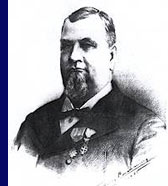 Benjamin
Hotchkiss was actually American by birth, and an arms manufacturer
by trade. In the late 19th Century, he came up with some
pretty elaborate designs for a repeat-action rifle. Strangely,
the US Government wasn’t interested in his new-fangled
revolving “machine gun”, so he headed across
the Atlantic and settled near Paris in 1867, where he established
the Hotchkiss Company. Hotchkiss was soon manufacturing
guns and armaments for the more forward-thinking French,
but sadly died in 1885, just before the design for his new
gun was perfected.
Benjamin
Hotchkiss was actually American by birth, and an arms manufacturer
by trade. In the late 19th Century, he came up with some
pretty elaborate designs for a repeat-action rifle. Strangely,
the US Government wasn’t interested in his new-fangled
revolving “machine gun”, so he headed across
the Atlantic and settled near Paris in 1867, where he established
the Hotchkiss Company. Hotchkiss was soon manufacturing
guns and armaments for the more forward-thinking French,
but sadly died in 1885, just before the design for his new
gun was perfected.
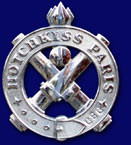 The
company continued, however, and the definitive ‘Hotchkiss’
8mm machine gun duly went into production. In gas-powered,
air-cooled form, it would ultimately become the standard-issue
heavy machine gun for the French and British armies during
the First World War.
The
company continued, however, and the definitive ‘Hotchkiss’
8mm machine gun duly went into production. In gas-powered,
air-cooled form, it would ultimately become the standard-issue
heavy machine gun for the French and British armies during
the First World War.
As
an established engineering company, Hotchkiss was in an
excellent position to exploit the dawn of motoring that
arrived with the turn of the twentieth century. Initially
designing and manufacturing components for other companies,
the company’s own motor vehicle first left the workshops
in 1903. Naturally, Hotchkiss veered towards the production
of military vehicles, and the company’s badge of a
pair of crossed canons graced many armoured cars and small
trucks.
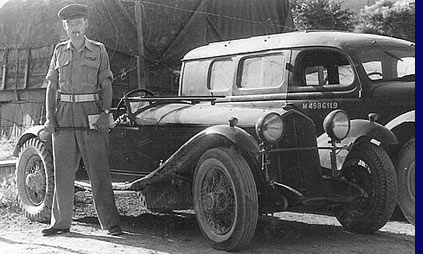 Between
the two World Wars, Hotchkiss produced a succession of small,
practical yet elegant motorcars, although many of these
still continued to be purchased by the military. During
this period Hotchkiss diversified into the manufacture of
racing cars, and with some considerable success. The AM80
won a hat-trick of victories in the Monte Carlo Rally between
1932 and 1934, winning again in 1939. After the War, Hotchkiss
won the Rally again in 1949 and 1950. No mean achievement.
The “works” team even raced at Brooklands.
Between
the two World Wars, Hotchkiss produced a succession of small,
practical yet elegant motorcars, although many of these
still continued to be purchased by the military. During
this period Hotchkiss diversified into the manufacture of
racing cars, and with some considerable success. The AM80
won a hat-trick of victories in the Monte Carlo Rally between
1932 and 1934, winning again in 1939. After the War, Hotchkiss
won the Rally again in 1949 and 1950. No mean achievement.
The “works” team even raced at Brooklands.
During
the Second World War, Hotchkiss concentrated on what it
knew best, and produced one of the world’s first four-wheel-drive
military vehicles, as well as guns and light armoured tanks.
Over 1000 of these tanks were already in service by the
time the Germans invaded France in 1940, and were considered
so effective by the advancing army that the Germans pressed
them into service.
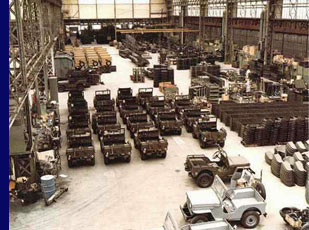 Henry
Ainsworth, the Managing Director of Hotchkiss, escaped from
Paris and moved to London, where his expertise was put to
excellent use. He was influential in the design of the famous
Willys Jeep, and after the war obtained the rights to manufacture
the Jeep in the Hotchkiss factory in Paris. This continued
right though until the mid-Sixties (right), and
over 27,000 were built.
Henry
Ainsworth, the Managing Director of Hotchkiss, escaped from
Paris and moved to London, where his expertise was put to
excellent use. He was influential in the design of the famous
Willys Jeep, and after the war obtained the rights to manufacture
the Jeep in the Hotchkiss factory in Paris. This continued
right though until the mid-Sixties (right), and
over 27,000 were built.
Post-war,
the company’s fortunes went through a succession of
take-overs and mergers, and the Hotchkiss name finally disappeared
in 1972. Even so, for almost a century the name of Hotchkiss
had been associated with ingenuity and engineering excellence,
so perhaps not an inappropriate marque for the RML drivers
to employ for their parade through Le Mans. (If this has
whet your appetite, click the pictures for additional information
on Hotchkiss and the story behind the name, or visit the
Wikipedia
page.)
The
team’s Friday concluded with a dinner for the drivers
with the Mallock Club, and as early a night as possible!
